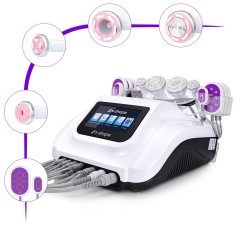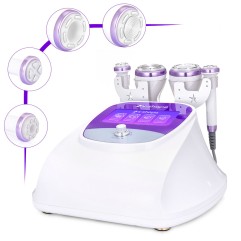Ultrasound technology has become a prominent therapeutic tool in various fields, including medicine and the beauty industry. In the beauty industry, ultrasound is used for various treatments, such as skin rejuvenation, body contouring, and cellulite reduction. The therapeutic effect of ultrasound depends on two key factors: frequency and intensity.
We will explore how ultrasound's frequency and intensity impact the beauty industry's therapeutic effect.
How Do The Frequency And Intensity Of Ultrasound Affect The Therapeutic Effect?
In the beauty industry, ultrasonic waves of different frequencies are applied to address specific concerns and target different tissue depths. The frequency and power or intensity of ultrasound play crucial roles in determining the therapeutic effect of beauty treatments. These parameters directly impact the depth of penetration, energy absorption, and biological response within the targeted tissues.
Low-frequency ultrasound, typically 20 kHz to 100 kHz, is commonly used for deep tissue penetration. It finds application in cellulite reduction and body contouring treatments, as it can effectively target subcutaneous fat layers. Low-frequency ultrasound is often used in beauty treatments that focus on fat reduction and body contouring. It can penetrate deeper into the tissues, targeting the underlying fat layers and facilitating the breakdown of fat cells. This makes it suitable for ultrasound-assisted liposuction or non-invasive fat reduction treatments. Low-frequency ultrasound has a greater depth of penetration, allowing it to reach deeper tissue layers. This can be advantageous for targeting stubborn fat deposits or treating cellulite. However, it may require longer treatment sessions.
High-frequency ultrasound, ranging from 1 MHz to 3 MHz, is suitable for superficial treatments. It is used in procedures like skin rejuvenation, acne treatment, and wrinkle reduction, as it can target the upper layers of the skin with precision. High-frequency ultrasound is effective in addressing superficial skin concerns. It can stimulate collagen production, enhance blood circulation, and improve the overall texture and appearance of the skin. This makes it valuable for treatments like skin tightening, wrinkle reduction, and scar revision. High-frequency ultrasound, with its shallower penetration, is better suited for treating superficial skin concerns. It can provide targeted treatment to specific areas without significant discomfort. The shallower penetration depth also reduces the risk of damage to underlying structures. However, high-frequency ultrasound may require multiple sessions for optimal results.
What is ultrasonic cavitation machine power?
Intensity (W/cm2). This is the power of the sound energy and drives temperature effects. The higher the power and intensity, the shorter the treatment time to produce a thermal effect and the stronger the thermal effect. A low-intensity beam is low power, over a large area, and for a short amount of time to ensure no damage to body tissues.
Biosafety parameters are published by the American Institute of Ultrasound (AIUM). The Spatial Peak Temporal Average (SPTA) is the average intensity over a time and area. The biosafety guidelines are
a. < 1-degree centigrade increase
b. SPTA < 100 mW/cm2 (unfocused beam)
c. SPTA < 1000 mW/cm2 (focused beam)
d. Ppeak < 10 MPa (3300 W cm-2)
The safety standards from the International Electrotechnical Commission (IEC) are:
a. SPTA < 100 mW cm-2
b. Output Beam < 20 mW cm-2
c.Ppeak < 1 MPa
Different combinations of ultrasound frequencies and powers
The relationship between frequency and power in ultrasound treatments is crucial in achieving desired outcomes in the beauty industry. The selection of appropriate combinations of frequency and power levels is determined by the specific treatment goals and target tissues. Different combinations offer unique advantages and disadvantages.
application of different combinations of ultrasound frequencies and powers in the beauty industry:
1. Low frequency and low power( 0.125–7 W/cm 2) :
This combination is commonly used for deep tissue treatments such as body contouring and fat reduction. Low-frequency ultrasound waves penetrate deeper into the tissues, targeting subcutaneous fat and promoting fat cell disruption. Low power levels ensure safety and minimize the risk of adverse effects.
2. High frequency and low power:
This combination is often employed for superficial treatments like skin rejuvenation and wrinkle reduction. High-frequency ultrasound waves have shorter wavelengths, enabling better absorption by superficial tissues. Low power levels allow for gentle heating and stimulation of collagen production, promoting skin tightening and wrinkle reduction.
3. High frequency and high power(17.5 W/cm 2~1000 W/cm 2):
This combination is suitable for specific applications that require both deep tissue penetration and significant energy delivery. It can be used for procedures such as deep tissue massage, where higher power levels are necessary to target and relax deep muscles and promote blood circulation. However, caution must be exercised to avoid excessive heating or discomfort to the patient.
4. Low frequency and high power, rare on the market.
It is important to note that the selection of the appropriate combination of frequency and power should be determined by the practitioner based on the specific treatment objectives, patient characteristics, and equipment capabilities. A thorough understanding of the advantages and disadvantages of different combinations allows for the safe and effective utilization of ultrasound in the beauty industry.
Selection factors of ultrasonic frequency and power
1. Depth and size of the target tissue:
The choice of ultrasonic frequency and power depends on the depth and size of the tissues being targeted. Different areas of the body have varying tissue depths and sizes, requiring adjustments in frequency and power settings accordingly. For example, superficial treatments like skin rejuvenation may require higher frequencies, while deeper tissue treatments like body contouring may benefit from lower frequencies.
2. Patient's age, weight, and health status:
Considering the age, weight, and overall health status of the patient helps in determining the appropriate ultrasonic frequency and power settings for optimal treatment outcomes. It ensures that the treatment is customized to the individual's specific needs, enhancing safety and efficacy in the beauty industry.
3. Frequency and power adjustment range of the device:
When selecting an ultrasound device for beauty treatments, it is important to consider the frequency and power adjustment range it offers. Different treatment goals and target tissues may require specific frequencies and power levels. Having a device with a wide range of frequency and power options allows for greater flexibility in tailoring treatments to individual needs.
4. Focusing and diffusion techniques of the device:
The focusing and diffusion capabilities of the ultrasound device also influence the selection of frequency and power. Focusing techniques concentrate the ultrasound waves into a specific area, allowing for precise treatment of smaller target areas. Diffusion techniques disperse the ultrasound waves over a larger area, suitable for treating broader regions. The choice between focusing and diffusion depends on the treatment objective and the size of the area being treated.
The Major Difference Between 20k, 25k, 30k, 40k, 60k, and 80k Cavitation Machines
The usage of cavitation machines is becoming increasingly popular due to their effectiveness in body sculpting and contouring. There are so many different models of cavitation machines. The significant difference between 20k, 25k, 30k, 40k, 60k, and 80k cavitation machines relies on their features.
The frequency determines the power output of the machine and its suitability for different treatment areas. This frequency range is chosen because it optimally targets fat cells while minimizing the impact on surrounding tissues. Higher frequencies can result in decreased penetration depth, while lower frequencies may cause discomfort or damage to the skin.
When choosing a cavitation machine, it's essential to decide on the frequency that best suits your needs based on the treatment area and the amount of fat or cellulite you want to target. By selecting the right frequency, you can verify that you get the quality output from your cavitation treatment.
20k~40k Cavitation Machine:
The 20k~40k Cavitation Machine utilizes ultrasound technology at a frequency of 20~40 kHz to generate high-intensity, low-frequency sound waves. The Cavitation Machine is primarily used for body contouring and cellulite reduction. It targets localized areas of stubborn fat deposits, such as the abdomen, buttocks, arms, and love handles.
60kHz~80kHz Cavitation Machine:
The 60kHz 80kHz cavitation machine operates on the same principle as the 40kHz machine, but it utilizes higher frequency ultrasound waves. The increased frequency allows for more precise targeting of smaller fat cells and can penetrate more superficially into the skin. The cavitation machine is suitable for treating smaller localized areas of fat, such as the chin. It is effective for body contouring, reducing double chins, and treating smaller pockets of stubborn fat.
Cavitation Machine Applicable Objects:
The Cavitation Machine is suitable for individuals who are looking to reduce localized fat deposits and improve body contours. It is most effective for people who are close to their ideal weight but struggle with specific problem areas that are resistant to diet and exercise. It is not a weight-loss solution for individuals who are significantly overweight or obese.
Cavitation Machine Treatment Period:
The treatment period can vary depending on the individual and the desired outcome. Generally, a series of treatment sessions is recommended to achieve optimal results. Each session typically lasts between 30 to 60 minutes, and it is advised to have a gap of one to two weeks between sessions. The total number of sessions required can range from four to eight, depending on the specific goals and the individual's response to the treatment. The treatment should be avoided if you have certain medical conditions, such as liver or kidney disease, cardiovascular issues, or if you are pregnant or breastfeeding.
Final Thoughts
Its non-invasive nature, safety, lack of recovery period, and high efficiency contribute to its popularity as a sought-after treatment modality in the beauty industry. Unlike surgical procedures, ultrasound treatments do not require incisions or anesthesia, making them a preferred option for individuals seeking non-surgical alternatives. Patients can typically resume their daily activities immediately after the treatment session, making it a convenient option for those with busy lifestyles. Due to the availability of many models, choosing the best cavitation machine for your needs is becoming overwhelming for beauty.
You may like
-

-

Brand: ARISTORM
ARISTORM S Shape 30khz Cavitation Machine for At-Home Body Contouring Skin Tightening
$650.00



